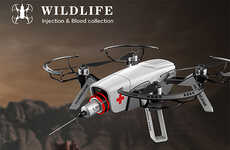
This Animal Poaching Prevention Effort Uses IoT and LPWAN Technologies
Alyson Wyers — September 19, 2017 — Eco
References: zsl.org & springwise
Last year poachers killed at least 35,000 African elephants and species such as the black rhino and mountain gorilla continue to be at risk -- which is why poaching prevention is such a timely issue.
The Zoological Society of London (ZSL) and Digital Catapult (a non-profit technology firm) are working together on poaching prevention. The two organizations are developing anti-poaching technology using the Internet of Things (IoT) and Lower Power Wide Area Network (LPWAN). They're building a satellite and sensor-equipped network that would empower conservationists in remote national parks and game reserves to not just monitor endangered wildlife, but also respond to threats of animal poaching taking place on land and at sea. The connected sensors would be able to communicate with each other over great distances using minimal power, detect nearby activity and send alerts when poachers are detected.
The Zoological Society of London (ZSL) and Digital Catapult (a non-profit technology firm) are working together on poaching prevention. The two organizations are developing anti-poaching technology using the Internet of Things (IoT) and Lower Power Wide Area Network (LPWAN). They're building a satellite and sensor-equipped network that would empower conservationists in remote national parks and game reserves to not just monitor endangered wildlife, but also respond to threats of animal poaching taking place on land and at sea. The connected sensors would be able to communicate with each other over great distances using minimal power, detect nearby activity and send alerts when poachers are detected.
Trend Themes
1. Internet of Things (iot) in Wildlife Conservation - Opportunity to incorporate IoT technology to monitor and protect endangered wildlife from poaching.
2. Lower Power Wide Area Network (LPWAN) for Anti-poaching Efforts - Utilizing LPWAN to create a network of sensors and satellites for real-time tracking and response to animal poaching threats.
3. Connected Sensors for Remote Anti-poaching Surveillance - The development of connected sensors enable better monitoring and immediate alerts when poachers are detected in remote national parks.
Industry Implications
1. Wildlife Conservation - The application of anti-poaching sensors provides an innovative solution for protecting endangered species in game reserves and national parks.
2. Technology - The convergence of IoT and LPWAN technologies presents an opportunity for technology companies to develop anti-poaching solutions.
3. Security - The use of connected sensors and real-time monitoring systems opens up possibilities for security companies to provide anti-poaching services.
2.2
Score
Popularity
Activity
Freshness























